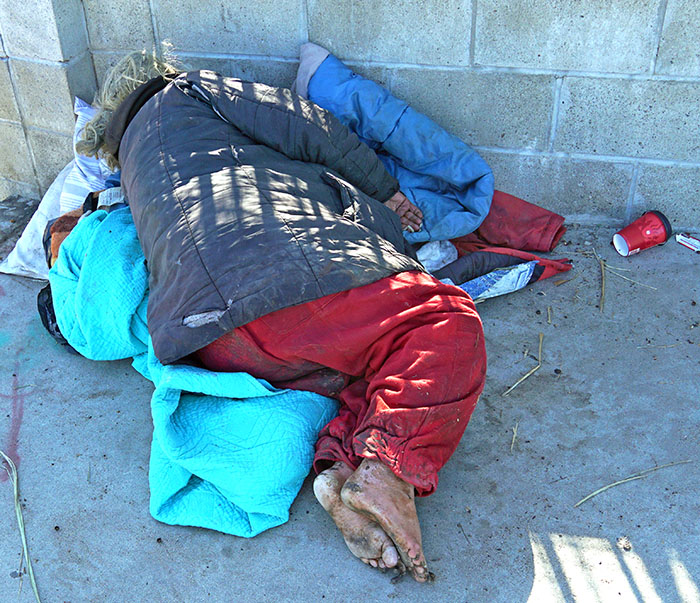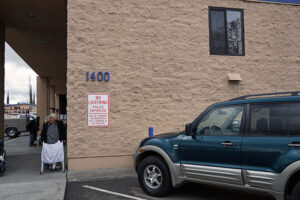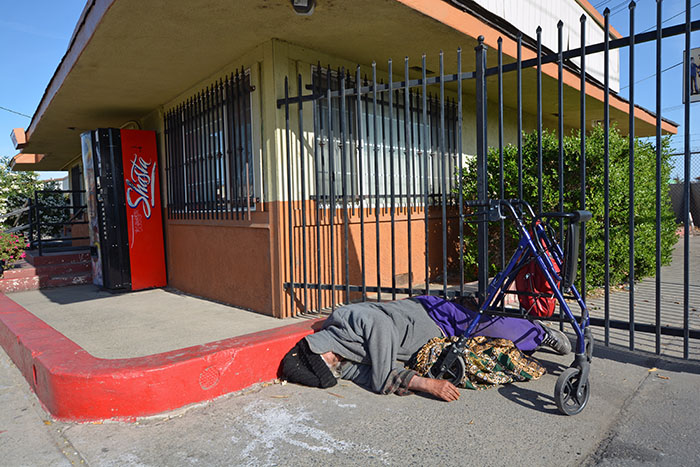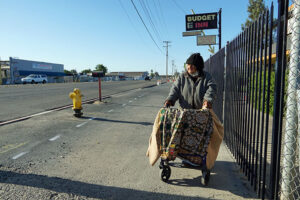We first saw Cheryl Littlefield on south 9th Street in Modesto in late January. She was badly soiled and had obviously been sleeping outside for several weeks. Her fingernails and toenails were grotesquely long and dirty. Prior to living on the street, Cheryl had had a room at a nearby motel. She said she lost the room when it, “caved in.”
Her income is managed by a local payee. Payees are assigned to people who can’t manage their money. The payee makes sure rent and other necessities are paid before issuing whatever is left over to the client.
In March, the manager of Cheryl’s former motel room said the payee had moved her to a different location. She says she’s unaware of the move and seems determined to stay within a few blocks of the motel she lived in for years.
Around mid-March, after repeated attempts by county workers to get her to a shelter — she refused to go in — Modesto Police Sargent Mike Hammond and the Homeless Engagement and Rescue Team (HEART) were able to get her into an ambulance. She was taken to a Modesto hospital for evaluation.

Once released from the hospital, Cheryl went to the Modesto Gospel Mission. Or maybe she went to Stanislaus County’s Behavioral Health and Recovery Services (BHRS) center. In a typical scenario, no one who has tried to follow her case is certain exactly where she went, or how, or when. Some think she was turned over to Adult Protective Services. Confidentiality rules prohibit hospitals, public agencies, and public employees from releasing information that might promote better understanding of the breakdown of our systems of care, so Cheryl’s exact path is difficult to follow.
For a while, once she was at the Mission, Cheryl slept on the concrete entryway at the entrance, sometimes in her own waste. After a few days, she began going inside at night, and using the beds and showers. By then, she had clean clothing and her nails and hair were tended. She spent her days outside on nearby sidewalks.

After a few weeks at the Mission, Cheryl wandered away. She was located and turned over to another agency, or maybe Adult Protective Services again. The few people who know exactly what happened won’t talk.
She then spent a few days at a transitional care home. At some point, Cheryl had a room at a motel on McHenry Avenue. The manager of that motel thinks she was there for “about eight days.” He says she was taken away by a, “blue van.”
Cheryl says her payee removed her from the motel and brought her back to her current location on south 9th Street, exactly where she was found in January. Her memory may or may not be reliable. When asked how long she’s been back on the street, she says, “Since June 1st.” She doesn’t know the year, day, or month, and doesn’t know who the president is.
When people talk about cases like Cheryl’s, they invariably invoke clichés about, “falling through the cracks” and “gaps in the system.” Those responses are misleading. There are no cracks and there is no system. For most homeless people in dire need of help, there is only a yawning hole, the upper rim of which is composed of social services, churches, charities, non-profits, and volunteers, all of them underfunded, understaffed, and overwhelmed. The least understood component is social services.
Government funded social services are the supposed safety net into which people like Cheryl Littlefield are placed. Again, it’s not a net, it’s a hole. People like Cheryl Littlefield often run the gauntlet of services, sometimes over a period of months, only to find themselves back on the street, often the very same places they fell into the hole we know as the, “system of care.” It’s also known more widely as, “help,” a misnomer that has thus far prevented the public from understanding the primary reasons homeless numbers keep growing.

For the seriously mentally ill, one of the stops along the rim of the help hole is jail. That’s where Mary Baca is now. We first wrote about Mary almost six years ago. She’s clearly schizophrenic (see minute 4:33 of video and on) and to the best of our knowledge has had exactly one visit to BHRS during all her years on the streets. Once out of jail, she will almost certainly be returned to the streets.
Mary’s case isn’t unusual. In fact, jail has become the default alternative to the streets for mentally ill homeless people. Between 2009 and 2019, “the proportion of incarcerated individuals with an open mental health case in California jails rose from 19 percent to 31 percent.” Even more telling, the total number of prisoners actually decreased during that same ten-year period. Yes, the number of people incarcerated for crimes decreased even while the number of mentally ill prisoners rose.

Cheryl Littlefield may or may not be mentally ill; however, she’s clearly unable to take care of herself. At 74 years old, her money has to be managed, she sleeps on the streets, and when asked where the bathroom is, she points to her trousers.
This week, after county outreach workers were notified Cheryl was back on the street, they approached her with offers of assistance. She politely declined, and, in the public eye, will be seen as yet another homeless person who, “doesn’t want help.”
It may well be, however, that despite her diminished capacity, Cheryl Littlefield has learned firsthand that “help” for the homeless means a weeks- or months-long trip around our “system of care,” followed by a swift and efficient kick down the rabbit hole that leads back to the streets. No wonder she doesn’t want help.

How are the Europeans treating street people? Since they have more humane treatments for people violating laws, I assume with a stronger health care system they excel with mental illness, substance abuse and homelessness.
Eric, a great story that exposes the need to change our outreach approach from “They aren’t ready for help”, to “The client is always ready, but we may have to adjust our approach to do productive work with the client.” (1).
The “always ready” thinking is something I’ve been able to use in my outreach work because I fundamentally believe it’s the right human relations approach and because as an independent volunteer I have the time needed to build trusting relationships.
For me, it has proven itself over and over in its ability to engage clients and get them assistance where other more traditional methods have failed.
(1) From the book: Homeless Outreach & Housing First : Lessons Learned – Jay S Levy
Being able to feel and think one is included,
as opposed to being looked upon and talked to as an alien outsider, is the number one truth we all expect from others. Those who are not treated with inclusion will never let those who exclude them make any inroads. If there is any one thing that comes with living on the streets it is hypervigilence. One can spot hypocrisy instantaneously. That said, having read your many replys to Valley Citizen posts, I can see why people are more willing to put guards/walls down around you.. Jay S. Levy is a 30 yr vet in the War Against Failing the Homeless. His other 3 books on Homeless Narratives, Housing First & Pretreatment highlight the urgency of changing: the initial approach & ongoing followup. The authors address why current attempts fail. I have kept abreast of much of Levy’s work found all over the internet. I say this for others unfamiliar with Housing First. I recommend (if we Valley Citizens intend to close up the HOLE that Eric points out) that all counselors and agencies doing follow up & providing funding become very
familiar with Levy’s books and work. Let’s challenge some these local agencies to, at the very least,
read Levy’s books. Something has to change quickly. I was very disgusted with alot of the options on the survey. Surveys can be intentionally made to skew results. I agree places to get out of the heat and remain inside cooled off are essential. Safe parking for vehicles, day and night, is essential. Not being harrassed, by busy bodies who think they know it all, is essential. Pronto!!! Thank you, Frank
Tx Lou. It’s nice to hear from a fellow traveler. I have been promoting Levy to many with the hope of not only changing the narrative but of having an acknowledged and professionally trained group of folks to work with people experiencing homelessness. We do have some great folks out there but many don’t get a lot of training nor are their salaries aligned with the tremendous responsibility of working with our broken residents who happen to be homeless. Follow the money, we actually get very little compared to the need! We have a lot of work to do. maybe you can join in by participating in our newly chartered non-profit, Stanislaus Homeless Advocacy and Resources Enterprise (SHARE). See my post below to Sandi.
This story needs to be shared over and over.. Cheryl’s story should move everyone to the core and we need to work on solutions for our fellow citizens. The payees that are appointed for management of the funds needed for Cheryl and others should be held accountable. Instead of wasting our taxpayer dollars on useless programs we need to implement solutions for offering a hand-up to people diagnosed with mental illness. So many Americans take for granted the rights and freedoms set before them and prefer to turn away from the Cheryls in their community. Instead of complaining about the state of our nation we need to start in our communities and be the change for a brighter future.
Hi Sandi. For more info. on helping, if your use Facebook, check out the SHARE page. An excerpt below.
The Stanislaus Homeless Advocacy and Resource Enterprise (SHARE) believes that all people deserve to be treated with respect and dignity, including people experiencing homelessness in our community.
As an organization SHARE will accelerate the involvement and education of the community. In order to move forward together, we will employ strategies which identify and solve problems using our valuable human resources and civic resources, to boost civic engagement, create opportunities and offer equitable access to all public and private resources within our community. Funds we raise each year will be granted solely to this end. Working 100% to propel our mission forward.
SHARE’s mission:
1. Utilizing a dedicated group of volunteers who work with people currently experiencing homeless and/or ones who need assistance after they have obtained housing, to fulfill their agreed sustainability goals.
2. Involve and educate the community at large on the many issues relating to homelessness and engage them to develop solutions.
3. Attempting to assist as many families and citizens out of homelessness, and its many symptoms and causal effects, toward a gratifying and safe lifestyle.
Amen.
Let’s recognize that being homeless can also causes mental illness. Daily chipping away at a human beings ability to cope. How much greater does living without the basic means of existence cause the already diagnosed mentally ill being to diminish?
These people are beacons, beacons of what is wrong in our whole (the human experience/civilization/sovereignty) until we see their true value….we cannot heal as a whole or heal these people, who are the strongest of us all. The ones who constantly flash the light of, “this is wrong”.
I am entangled
I wonder, did this man bring her water?
Are we really trying to help?
All I can think is “why didn’t I wash her hands and feet”
❤️❤️❤️
Cheryl littlefeild is my grand mother we have been there to help her multiple times she refuses every time I’ve tried getting help all the time my whole family has I love my grandma and have only met her twice my whole life I got to spend this last Mother’s Day with her she deserves to be with her family not a home goddamn it!
Than you, Luke, for sharing your pain…